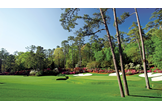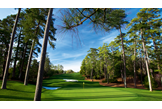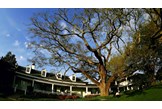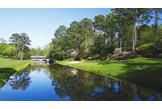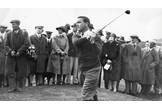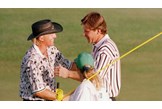Augusta: Golf’s field of dreams
Published: Last updated:
You may swoon over the historic grandeur of St Andrews, marvel at the wave-crashing majesty of Pebble Beach and embrace the purity of Royal Melbourne. But then, there is Augusta National, home of the Masters, where one word is sufficient: Unique.
No other golf course, no major venue can be compared to this holy acreage where, it was once said, the road to immortality is 7,435 yards long. Records and legends have nudged each other all the way since the tournament began in 1934. Heroics outweigh statistics in this corner of Georgia.
The first tingle of excitement begins when you touch down at Augusta’s Regional Airport (Bush Field) and head for the course. Never was a normally boring drive into a mundane Deep South town more exciting. Washington Road, a strip of fast-food restaurants and basic motels, hides its secret well. You could drive past Augusta National without noticing the small gatehouse that leads to the course. Magnolia Lane may be the most famous approach in golf. It is just 330 yards from the gate to the attractive, low-slung clubhouse through an avenue of 150-year-old magnolias standing as sentinels. Every tree could tell a Masters story.
Before a ball is struck, the first-time visitor feels compelled to take in the scene that presents itself on the golf course side of the clubhouse. When David Feherty, formerly a European Ryder Cup player, first visited Augusta National for his Masters debut he intended to go straight into a practice round. Then he cast his eyes across the panorama of rolling undulations, towering pines and the absolute greenery of everything, and told his caddie to find a golf cart so that they could tour the 18 holes on wheels.
“I didn’t want to be distracted by all this beauty and variety while I was playing,” he said, “I am glad I took that tour. Going along the 7th I half-expected a Salvador Dali clock to come tumbling from a tree.”
The Irish American commentator was not alone in his astonishment at the quality, tranquillity and occasional quirkiness of the course.
Any first-time visitor has much to absorb, not least some of the traditions. Spectators are always referred to as ‘patrons’ and every year they bring their folding chairs, place them behind their favourite green or fairway. If they go for a walk or a refreshment, the empty chairs remain untouched until they return.
The refreshments are always wrapped in green, drinks in green mugs. Start sheets are distributed free. And there is strictly “no running”. Ask Dougie Donnelly, who was very close to being thrown out on his way from the 18th green to the BBC compound after exhibiting some indecent haste.
The Masters is also distinguished by the fact that it returns to the same venue every year, while the other three majors move around. Tickets tend to remain in families, passed down through generations.
I have attended 25 Masters and nothing diminishes the joy of the place. Even the town takes on a special buzz. Some restaurants will tell you that the money spent by outsiders keeps them in business for the rest of the year. A barmaid once whispered that she made $10,000 dollars in tips during Masters week.
Much of the magic of Augusta stems from the stories of events on the golf course, which are embedded in history. They began very soon after The Legend, Bobby Jones, and Clifford Roberts embarked on their quest to turn a market garden into a golf course in the early Thirties.
In only the second Masters, 1935, Gene Sarazen produced “the shot that was heard around the world,” when he holed his second shot at the par-5 15th on the way to forcing a play-off with Craig Wood. He won that, over 36 holes, by five shots.
Gary Player, three times a Masters winner, and never a man to hold back in pursuit of ambition, tells how he wrote to Roberts pleading for an invitation to play, saying that the members at his club would fund him with a collection. Roberts wrote a succinct reply: “Pass the hat.” Later, playing a social round with former chairman Hootie Johnson who was faced with a tricky putt, Player announced: “If you hole that I will eat the golf ball.” Johnson duly sank the putt and for years the restaurant staff would say to Player: “Would you like your golf ball boiled or baked, sir?”
There have been sombre times, too, but they only add to the mystique of Augusta National. Roberto de Vicenzo, the likeable Argentine who won the Open Championship at Royal Liverpool in 1967, was poised to take on Bob Goalby in a Masters play-off the following year. He shot a 65 but mistakenly signed for a 66, after Tommy Aaron had put him down for a ‘4’ instead of a birdie ‘3’ at the 17th. Vicenzo blamed himself as Goalby took possession of the famous Green Jacket.
Nothing could have been more emotional than Ben Crenshaw’s win in 1995. Shortly before the tournament his revered, 90-year-old coach, Harvey Penick, had given him a putting lesson. Penick died as Crenshaw was flying to Augusta. The day before the Masters’ opening round Crenshaw flew back to Austin, Texas, to act as a pall-bearer at the funeral.
As Crenshaw holed the winning putt he shook with a vivid outpouring of sobs and tears and was held up by his caddie. The patrons were united by his grief.
But there were glory days, especially during that period when the Masters almost became European property with Sandy Lyle (1988), Nick Faldo (’89 and ’90), Ian Woosnam (’91), Bernhard Langer (’93) and Jose-Maria Olazabal (’94) taking their jackets.
The third of Faldo’s wins, in 1996, has gained its place in Masters lore because it was achieved despite a final-round six-shot deficit to Greg Norman. Walking with that match you could see Norman wilting, shoulders dropping, most noticeably when his approach to the 9th pitched by the pin, but spun back 40 yards down the slope. Just being there almost amounted to an intrusion of private grief.
Other giants have emerged to dominate the game. When Tiger Woods won by 12 shots in his first major as a professional, it sent shockwaves through golf. Phil Mickelson emerged as his biggest rival and then there was the arrival of Rory McIlroy, a young Ulsterman made stronger by squandering a four-shot lead at the 2011 Masters to shoot an 80. He answered every amateur psychologist by winning the US Open two months later.
Topics of Masters conversations cover many aspects of this gloriously manicured cathedral of dreams. The cheers seem to echo in the pines and the Hogan roar was superseded by the Nicklaus roar, then by the Tiger version, and maybe this year by the Roary Roar.
No tree could tell better stories than the old oak on the lawn, outside the clubhouse. It is huge and very close to the 1st tee and the practice green; and anyone who is anyone uses it as a traditional gathering and meeting point. You might catch Gary Player chatting to Rory McIlroy, or Jack Nicklaus to Tiger Woods.
Visit the Nicklaus plaque between the 16th and 17th fairways. And the Arnold Palmer plaque at the water-fountain behind the 16th tee, recording his 50 consecutive appearances and four victories.
But, the piece de resistance on the course is, predictably, Amen Corner, that spot far away from the clubhouse where a fiendishly difficult par 4 (11th) is followed by a ticklish par 3 (12th) and an awkward par 5 (13th). This is where the players get to escape momentarily from the crowds. The writer, Herbert Warren Wind, gave this potentially card-wrecking three-hole stretch the name Amen Corner. The towering trees disguise the swirling wind. There is water on all three holes, notably Rae’s Creek, named after John Rae who died in 1789 and whose house kept residents safe when the Indians were attacking Fort Gordon. The first and only time I got on, I drowned a ball on all three, 11th to 13th.
Seve Ballesteros, twice a winner, fell in love with Augusta when he first travelled to Georgia. He marvelled at the trees, the dogwoods, the azaleas and, naturally, the challenges the course threw up. He said it demanded his respect: “I treat it like an older person.”
He loved it so much that when he formed his management company he named it Amen Corner.
Why is Augusta so special? Why does it lift our hearts each and every April? It is because there is a reverence about the place. There is the lawn with its green-and-white parasols where inexpensive lunches and Southern cocktails known as ‘Azaleas’ are served. There is an atmosphere of a Victorian Garden Party about the place, with girls in summer dresses sipping mint juleps. Last year, for the first time, there were two women in Green Jackets, former US Secretary of State, Condoleezza Rice and financier Darla Moore.
There is the proximity of the players. It is the only tournament where no one except the golfers, their caddies and a scorer are allowed inside the ropes.
Augusta National leaves its mark on everyone. It pulls people back year-on-year with its magnetism. And those of us who have had the privilege of playing there on the Monday after the main event have memories to take to our last breath on earth.

